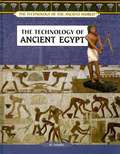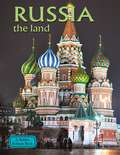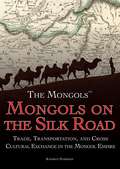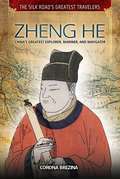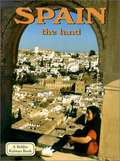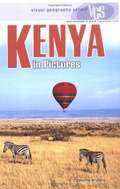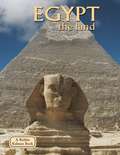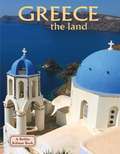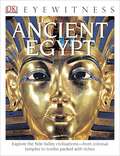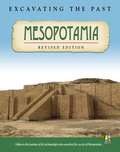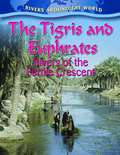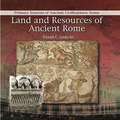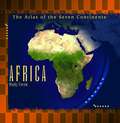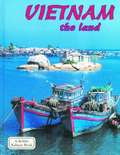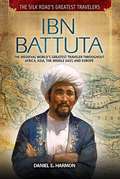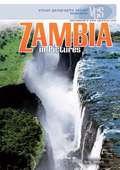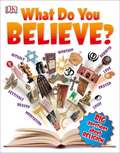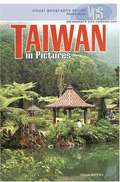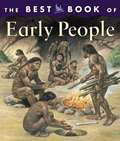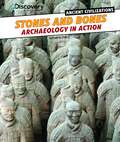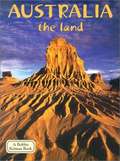Special Collections
District List: NYC Core Curriculum 6th - Social Studies
Description: The New York City Core Curriculum program aims to provide a high-quality curricula to NYC students through a seamless instructional program across grades and subjects. This list has been curated by NYCDOE for 6th Grade Social Studies materials. #nycdoe
- Table View
- List View
The Technology of Ancient Egypt
by M. SolodkyStudents may have heard of papyrus and the pyramids, but this insightful book outlines many of the lesser known technological advancements that were the product of a fiercely creative, intelligent, and inventive ancient society. Covering such things as mummification and elaborate tombs, The Technology of Ancient Egypt is sure to keep students on the edge of their seats. Some scholars believe that more than half of the basic inventions on which today's world depends came from ancient China. The ancient Chinese made the first iron plows in the world and also invented the wheelbarrow, the seismograph, and many other invaluable things. Readers will learn about the many technologies that the Chinese created or improved upon. Supports history-social science content standards mandating student understanding of the origins and influence of agricultural, technological, and commercial developments in key ancient civilizations. Broadens student understanding of the relationship among science, technology, and society by highlighting how major scientific and mathematical discoveries and technological innovations have affected societies throughout history.
Russia
by Greg NicklesDiscusses Russia's geography, history, ethnic groups, wildlife, climate, cities, economy, agriculture, transportation, and space program.
Mongols on the Silk Road
by Kathryn HarrisonStretching across Asia and into eastern Europe and northern Africa, the Silk Road opened the world to new ideas, products, and cultures. Because the Mongols controlled so much of the territory across this network of pathways, trade between east and west flourished, spreading silk, spices, technology, and languages. In addition, the Mongols were known for their different religious traditions, including Buddhism, Islam, and Zoroastrianism, which were also “transported” along the established pathways of trade. While traveling throughout the network could be treacherous, its cross-cultural exchange paved the way for modern globalization. This vivid and lively account places sets readers on a wondrous journey of discovery along the Silk Road.
Zheng He
by Corona BrezinaZheng He was the commander of a vast Chinese fleet known as the treasure fleet. In the early fifteenth century, he led the fleet on seven journeys throughout the South China Sea and Indian Ocean, serving as ambassador to the barbarian nations in need of a civilizing influence. Under Zheng He’s command, the Chinese treasure fleet achieved one of the most impressive maritime displays the world had ever seen. This engaging volume covers the fleet’s travels, which covered more than 40,000 miles and included sea routes along the Silk Road, to cities and kingdoms from southern Asia to east Africa.
Spain
by Noa Lior and Tara SteeleExplores Spain's varied geography from the Cantabrian Mountains in the north to the southern Sierras and the vast rivers and coastal regions of the Atlantic and Mediterranean.
Kenya In Pictures
by Catherine BrobergA brief overview of Kenya's land, history, government, people, and culture.
Egypt
by Arlene MoscovitchEgypt is a land of timeless monuments and artifacts. It is also a land marked by the changes brought by the modern world; where camel drivers talk on cell phones and ancient tombs are moved to make way for modern dam building projects. With photographs, this work addresses the problems of pollution, global warming, and erosion on the land.
Greece
by Sierra AdareTakes you through the ancient and modern history of Greece. This work introduces you to the ancient city states such as Sparta and the modern cities of Athens and Patras. It also includes topics such as: roads, new and old; the origins of Greece; modern industries; and tourism, fishing, and farming.
Ancient Egypt
by George HartIn Eyewitness: Ancient Egypt, travel back in time and discover one of history's most remarkable civilizations — from the legends of the great Pharaohs to the triumphs of the ordinary people. Explore the inside of the Great Pyramid in Giza, or learn how Tutankhamun's tomb was found.
Images and supported text throughout the book showcase the pottery, weapons and other objects Ancient Egyptians left behind, the architecture they created, the food they ate, their system of Hieroglyphic writing, and more, giving an eyewitness account of this incredible empire.
Mesopotamia
by Jane ShuterMesopotamia hides many wonders, waiting to be discovered when you see what it takes to excavate the past.
The Tigris And Euphrates
by Gary MillerThe Tigris and Euphrates rivers surround a region once known as Mesopotamia, the "cradle" of ancient civilizations that included Sumer, Babylonia, and Assyria. This fascinating book follows both rivers from where they begin in Turkey, travel down through northern Syria and Iraq, and join to form the Shatt al Arab before emptying into the Persian Gulf.
The Technology Of Mesopotamia
by Graham FaiellaThe Mesopotamian civilization was the first to build cities, and their inventions and technologies evolved with their urban life. They learned how to build all kinds of buildings, from ordinary houses to royal palaces. In this compelling narrative, students learn about some of Mesopotamia s most important inventions and how many of these inventions survived and continue to be used today.
The Indus Valley
by Ilona Aronovsky and Sujata GopinathContents include: The Lost Cities of the Indus Civilization; Constructing Great Cities (The cities of the rivers, Monumental Mohenjo-daro, An Indus Valley home, Excavating Harappa, Dholavira); Clues to Daily Living (Jobs, Figuring out figurines, Food and cooking); The Mystery of the Indus Script; Traveling Far and Wide; Craft Technology and the Art of Fire; The Rulers and People; The End of the Indus Civilization; Archaeology Today; Timelines.
Land And Resources In Ancient Rome
by Daniel C. GedachtAncient Roman civilization has long been studied to discover what propelled this society to such great heights and to learn why it fell. Primary source imagery, artifacts, and interesting, kid-friendly text will keep students engaged as they learn about an ancient world cultures--an important part of the curriculum.
Africa
by Wendy VierowAfrica is a continent of 53 countries and is home to people who make up more than 800 ethnic groups. More than 5,000 years ago, the country of Egypt, located in northern Africa, was one of the world s greatest civilizations. Africa is the land of the Sahara, the world s largest desert. It also hosts the Democratic Republic of Congo, which has one of the world s thickest rain forests. Many important natural resources, from exotic animals to precious minerals such as oils and diamonds, can be found in Africa.
Vietnam - The Land
by Bobbie KalmanDescribes the geography, climate, history, cities, agriculture, transportation, business and trade, and wildlife of Vietnam.
The Story of Prehistoric Peoples
by Philip BrooksDescribes the lives of early prehistoric peoples, from the use of tools and the migration of early hominids around the world to human life during the Ice Age, the domestication of animals, and prehistoric art.
Ibn Battuta
by Daniel E. HarmonIbn Battuta, a fourteenth-century Moroccan adventurer and religious scholar, was one of the most ambitious travelers of the Silk Road. Scholars estimate his lifelong journeys covered no fewer than 75,000 miles. Because of his knowledge of Muslim history and laws, he was greatly respected by the Muslim rulers he visited. His geographical records helped fill in the pieces of a mysterious world.
Zambia in Pictures
by Bella WatersDescribes the geography, climate, wildlife, natural resources, history, politics, culture, economy, and government of Zambia.
What Do You Believe?
by Dorling Kindersley Publishing StaffReligion, morality, science, and the afterlife are complex and often misunderstood subjects. What Do You Believe? is a dynamic and clear text that brings together a variety of ideas of on religion. They are clearly presented for children to understand in a clear, unbiased text, and key concepts are broken down into manageable chunks of information with keywords that are simply explained. What Do You Believe? looks at basic teachings, practices of world faiths, philosophy, and more, and delves into the meaning and purpose of life. This book promotes understanding, tolerance, and respect for people whatever they believe.
Taiwan in Pictures
by Alison BehnkeAn overview of Taiwan's geography and history, along with an exploration of the political, economic, and cultural landscape of this Asian island nation off the coast of China
The Best Book of Early People
by Mike White and Margaret HynesChildren are very curious about who their prehistoric ancestors were, how they lived, and what they may have looked like, and The Best Book of Early People by Margaret Hynes and Mike White is just the source to satisfy emerging anthropologists. Children will learn how early families survived, hunted, gathered into primitive settlements, began to use tools, and invented farming techniques. Step-by-step illustrations and captions explore ancient villages and the work of the scientists who find and catalog their discoveries.
Stones and Bones
by Kathryn SteeleDiscusses the work of archaeologists and describes the sites and artifacts they work with, including such things as ancient cities and burial grounds, temples, sunken ships, tools, and writing tablets.
Australia
by Erinn BantingEarth did not always look as it does today. Hundreds of millions of years ago, it was covered by one enormous landmass called Pangaea. About 200 million years ago, Pangaea began to split in two. Slowly, the two pieces drifted farther apart and split into even more pieces. Eventually, the seven continents formed: North America, South America, Europe, Asia, Africa, Australia, and Antarctica. Australia and Antarctica drifted the farthest south, into the southern hemisphere.
